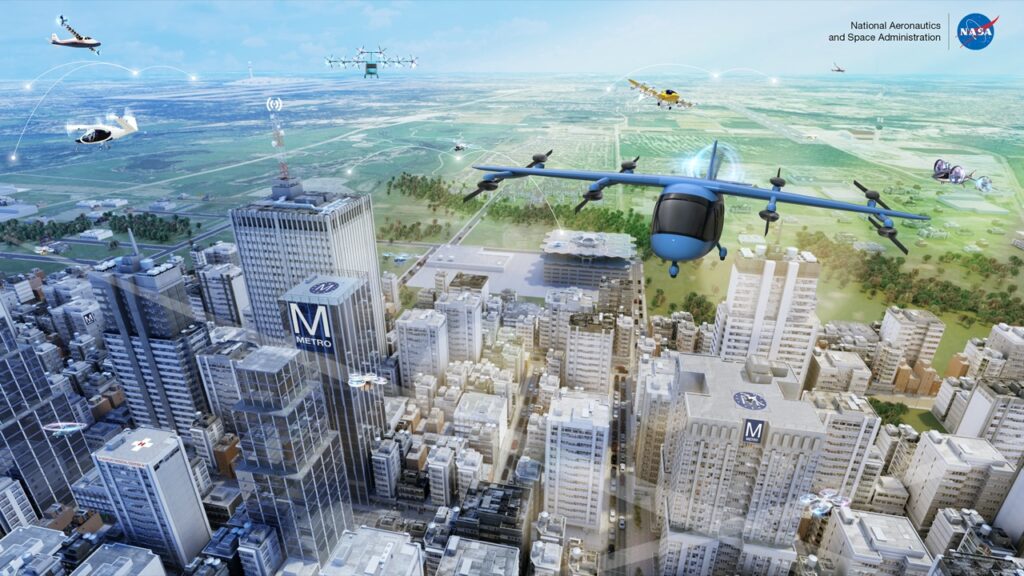
A workshop led by NASA this week offered an in-depth perspective on the progress of advanced air mobility (AAM) so far and the upcoming milestones for advancing and integrating AAM into the current airspace. (Photo: NASA)
NASA’s Advanced Air Mobility (AAM) Ecosystem Working Groups (AEWG) hosted a virtual workshop this week featuring discussions on AAM integration. Starting in June, the AEWG will develop more formal roadmaps based on the priorities and sequencing discussions taking place during this week’s workshop. Robert Pearce, NASA’s Associate Administrator, Aeronautics Research Mission Directorate, shared his perspective on AAM integration strategies. Two other representatives from NASA, Davis Hackenberg and Ken Goodrich, also discussed some of the next steps for establishing an AAM ecosystem.
NASA’s Robert Pearce emphasized that safety, sustainability, and scalability are top priorities for developing and integrating AAM. At the most basic level, AAM connects individuals to resources, services, employment, and community. As AAM evolves, Pearce stated, it will begin with providing air taxi services and delivery of goods, but the community is bound to find endless ways that AAM can add value. He sees access to healthcare as one area that will offer the most benefit for individuals. “Many Americans today—and people across the globe—living in rural areas don’t have access to healthcare. Imagine if AAM can increase the reach of our global healthcare systems and provide direct access to world-class healthcare,” he explained. “I look at the investments we make, and the benefits on the other end. If we can [achieve] scalability, this is going to deliver value many many times what we put into it.”
Some important challenges that NASA is in the process of addressing are propulsion reliability, noise impact and mitigation, and vehicle safety. The AEWG, Pearce noted, is helping to bring all of these elements together and facilitate coordinated progress in the approach to AAM integration. Pearce emphasized safety in particular: “You have to see safety distributed throughout. The National Campaign series creates an opportunity for more and more complexity in the architecture and in the operations, demonstrating that in flight where needed, to show what’s possible and where the issues are.”
Development of system architecture for AAM is one of the things that Pearce hopes to see next, in addition to research on autonomy and automation in general, for vehicles, the airspace, vertiports, and other areas. “That’s where we should start: to conceive of and develop and integrate automation architecture across all those elements,” he said. “We need to line up our collective efforts to that architecture. If we’re going to be scalable, we’re going to need that.”
Davis Hackenberg, AAM Project Manager of the Aeronautics Research Mission Directorate, shared the big-picture ecosystem goals for AAM. Moving from the Operational Safety Demonstration phase, he said, it will be necessary to hit certain milestones for the next phase: Initial Commercial Operations.
These are the upcoming goals and areas of focus that Hackenberg outlined for developing the AAM ecosystem:
- Initial AAM ConOps Development (by the end of 2022)
- Mature Certification Projects (2022)
- 1st-Generation AAM Aircraft (2023)
- Initial Aircraft Personnel Training & Licensing (2024)
- Initial Operational Approvals (2024)
- Integrated Low-Volume Airspace Operations (2024)
In 2025 and beyond, the focus will evolve into localized high-tempo operations, and then scalable, weather-tolerant operations. Initial infrastructure deployment should occur by the end of 2027, and we will see second-generation AAM aircraft before 2029. Finally, by the end of 2030, Hackenberg envisions automated flight and integration of automated systems. “We align our portfolio with how we see this ecosystem progressing and find areas where we can be leaders, build technologies, and partner with those in the industry,” he said.

Davis Hackenberg shared a diagram illustrating AAM and highlighting the four stages of maturity for integrated AAM operations. (Photo: NASA)
NASA’s Ken Goodrich, Deputy Project Manager for Technology, explained their system for defining progression in urban air mobility (UAM)—a framework referred to as UMLs, or UAM maturity levels. At maturity level one (UML 1), Goodrich said, “missions typically occur at the edges of the urban area. A key challenge of AAM is community integration; we see operations in much closer proximity to communities.” The focus will need to be providing benefits to the public, and “industry needs to be able to provide products and services that make investments worthwhile,” according to Goodrich.
At UML 2, initial commercial operations will leverage mainly existing infrastructure and will occur in just a few metropolitan areas to start. The selected regions at UML 2 will be likely to have favorable conditions for UAM including market volume, community acceptance, and weather conditions. Operations would also be taking place within the current national airspace system (NAS). “We expect these to start with low tempo pressure and a small number of operations,” Goodrich stated. “This is where revenue begins, but the ability to scale is limited. We need to complete the type certification process, we need to have the ability to license qualified pilots, and the operators and operations need to receive operational approval.”